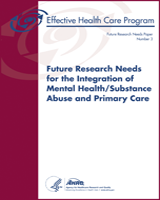NCBI Bookshelf. A service of the National Library of Medicine, National Institutes of Health.
Carey TS, Crotty KA, Morrissey JP, et al. Future Research Needs for the Integration of Mental Health/Substance Abuse and Primary Care: Identification of Future Research Needs from Evidence Report/Technology Assessment No. 173 [Internet]. Rockville (MD): Agency for Healthcare Research and Quality (US); 2010 Sep. (Future Research Needs Papers, No. 3.)

Future Research Needs for the Integration of Mental Health/Substance Abuse and Primary Care: Identification of Future Research Needs from Evidence Report/Technology Assessment No. 173 [Internet].
Show detailsMental health problems are among the most common problems encountered by primary care providers.3 Half of the care for common mental disorders in the United States is delivered in general medical settings.1 Primary care providers commonly diagnose and manage conditions such as dysthymia, major depressive disorder, problem drinking, and anxiety disorders. Multiple challenges exist in delivering high-quality mental health care in primary care settings.4 The quality of the care delivered in the primary care setting may vary: providers may have difficulty making referrals when needed to mental health professionals; the supply of mental health professionals may be inadequate in some areas; and patients may be reluctant to see a second provider. Patients with serious and persistent mental illness such as schizophrenia are often seen predominantly in specialty mental health settings yet often have substantial unmet general health needs including obesity, diabetes, and cardiac risk factors, sometimes exacerbated by medication treatment of their mental illness.5
“Integrated care” is one approach to addressing these currently unmet needs. In integrated care models, there is systematic linkage of mental health and primary care providers requiring communication or coordination between providers to meet both the mental and general health needs of the patients.2 The exact nature of the consultation and collaboration varies greatly across models, and may include telephonic or information technology. Often, a mental health professional is placed, permanently or intermittently, in the primary care practice. A key difference is that the integration implies a much closer and more coordinated system of care than prior consultation or referral models. Also key is the involvement of a second health care professional, which distinguishes integrated care from interventions that train primary care providers to treat patients with mental health conditions without the involvement of a mental health professional.
In 2008, the Agency for Healthcare Research and Quality (AHRQ), working with the University of Minnesota Evidence-based Practice Center (EPC), conducted a systematic review of the literature evaluating the integration of mental health and substance abuse treatment with primary care. The review addressed six key questions. A summary of the 2008 report’s conclusions, findings, limitations, and future recommendations is listed in Table 1.
Table 1
Summary of findings, limitations, and recommendations from the 2008 AHRQ review (modified using table 19 of the original report).
The Minnesota EPC authors found 33 trials examining the impact of integrating mental health specialists into primary care; 26 trials addressed depression. The studies reported positive results for symptom severity, treatment response, and achievement of remission when compared with usual care. The level of care integration did not seem to be related to treatment outcomes. The EPC authors also reported that the level of integration did not appear to be related to outcomes. Most of the studies addressed the integration of mental health professionals into primary care; few examined the integration of primary care into mental health. A majority of the studies have involved older patients, and some positive studies, having found improved outcomes with integrated care, have been largely composed of minority populations. The main barriers identified to a broader use of integrated care include programmatic costs, insurance coverage, and relationships with multiple payers. The VA was felt to offer a good model of a sustained program. Key elements of successful models included active support at all levels of the organization and specific funding.
The authors of the 2008 AHRQ review reported on a number of gaps/limitations (summarized in Table 1, reproduced from the original report). Several gaps identified little prior research in conditions other than depression or examined care integration in younger populations. Other gaps included little research in rural areas, little examination of the use of information technology, or little development of financial models. One of the largest gaps was the paucity of research on integrating medical care into mental health care for patients with serious and persistent mental illness.
In February 2010, AHRQ commissioned the RTI International–University of North Carolina at Chapel Hill Evidence-based Practice Center (RTI-UNC EPC) to work with stakeholders to develop a prioritized list of future research needs in this area that would inform researchers, funders, practitioners, advocacy groups, patients, and family members. A structured approach, including the AHRQ population, intervention, comparator, outcome, timeframe, setting (PICOTS) framework, to future research needs prioritization is new: this project therefore also served as a pilot for development and testing of methods to conduct such an evaluation. In the future, we anticipate that all AHRQ-sponsored comparative effectiveness research systematic reviews will contain a documentation of future research needs. In this report, we use the term “research gap” to indicate gaps from the report, the work with the stakeholders, and the RTI-UNC team review of the report; we used the identified gaps to generate “research needs,” including definitions of key study design issues such as PICOTS, and methods considerations such as feasibility and sample size.
- Background - Future Research Needs for the Integration of Mental Health/Substanc...Background - Future Research Needs for the Integration of Mental Health/Substance Abuse and Primary Care
Your browsing activity is empty.
Activity recording is turned off.
See more...